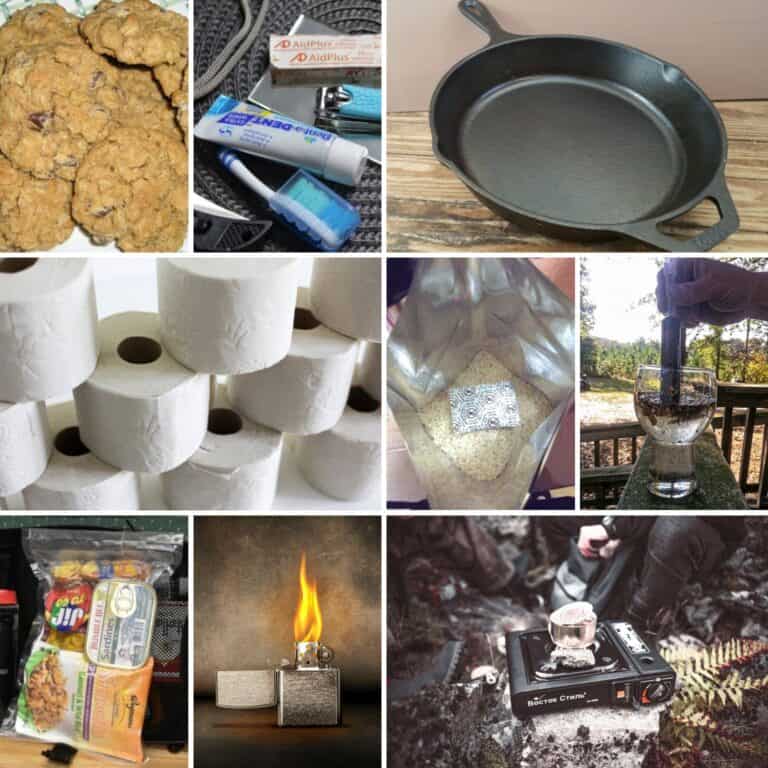When it comes to hoarding for an emergency situation bear in mind what is most likely to happen in your area – cyclones, flooding, riots, or earthquakes, and from there you can plan accordingly as regards time frames.

One week or two (or perhaps even more in the case of civil unrest or severe natural disasters) may leave you cut off from other people, and leave supermarket shelves empty because supply trucks are unable to get in to replenish goods.
In the flooding of March-April 2017 in Queensland Australia, it was amazing to see first hand how quickly those supermarket shelves were cleared and how difficult it was to get in fresh produce from the affected areas.
The list will be broken down into what is of utmost necessity in order to survive.
It’s very hard to prioritize items on the list because a person can’t go much more than 3 days without WATER, but without HEATING in cold climates a person can die from exposure to the elements within hours.
FOOD is important but you may not survive to eat it if you are not SECURE from danger and have MEDICAL SUPPLIES to treat injuries before infection sets in.
When you are cut off you need COMMUNICATION to know when it will be safe to venture out and where to go. You will also need PERSONAL HYGIENE items to stay healthy.
Disclosure: This post has links to 3rd party websites, so I may get a commission if you buy through those links. Survival Sullivan is a participant in the Amazon Services LLC Associates Program. As an Amazon Associate, I earn from qualifying purchases. See my full disclosure for more.
1. Water –two liters per day per person is average– more in hotter climates.
2. Personal water filter or tablets
3. Small camp stove, with spare gas cylinder to boil water and cook food in case of power cuts.
4. Good quality sleeping bags
5. Candles – for light, to warm food and create a clay pot heater.
6. Boxes of matches stored in a waterproof container and lighters
7. Flashlights /headlights – can be battery, solar powered or work with kinetic energy but preferably more than one type of power source with spare batteries
8. Sufficient firewood – in whiteouts people have been reduced to chopping up their furniture to keep warm and for cooking.
9. Gun(s)
10. Sufficient ammo for the above.
11. Tomahawk or a machete – defense, chopping kindling, rescue.
12. Multitool – Leatherman is a good one – you want quality that will last in trying conditions, not bits that will snap off!
13. Toilet paper – even if the toilets don’t work!
14. Wet Wipes – water is going to be in short supply for cleaning.
15. Hand sanitizer – same reason as above.
16. Toothpaste – no reason to have killer breath.
17. Zip lock bags – for just about everything.
18. Trash bags – to keep things tidy, act as emergency rainwear, protect goods from water.
19. Paper towels – clean ups to avoid using precious water.
20 Hand crank radio to get news updates and stay in the loop. Cellphones may die without power and networks may go down. Read this article which has all sorts of good advice before purchasing a ham radio if this is the first time you are planning on using one.
21. Flour to create your own griddle cakes, scones, wraps, bread.
22. Baking powder/dried powdered yeast
23. Brown Rice – it’s higher in protein.
24. Cooking oil – coconut and sunflower are good as they can take high heat and are nutritious – you can also use coconut oil as a skin moisturizer.
25. Cornmeal – for thickening soups, stews and in baking.
26. Beans, Chickpeas, and lentils – assorted beans in cans are high in nutrition and quick to heat. Remember dry beans and lentils will use more of your precious fuel to cook – this is fine if you have access to plenty of firewood over a long period of time.
27. Trail mix – make your own using sunflower seed, raisins, nuts, dried banana, coconut shavings and assorted berries with small chocolate chips.
28. Canned fish and meats – with power cuts fridges and freezers won’t work unless you have a gas freezer. Alaskan Wild Salmon is high in omega 3’s as well as sustainably caught tuna in cans.
29. Pemmican/jerky – remember when the power goes you need protein that can be stored on a shelf and not in a freezer.
30. Nuts – assorted – a good source of protein. Preferably unshelled and unsalted – cracking open the nuts gives kids something to do when shut indoors or in a bug out location.
31. Oats – quick, tasty and healthy.
32. Powdered or tinned milk/ soy milk or coconut milk
33. Honey – it lasts forever if its organic honey without any additives and can be used for medication, beauty and food; 3000 year old honey was found in the Egyptian pyramids and it was still good.
34. Sugar – yes you’ll need some as a pick me up and kids will need some as a treat in baked goods and a little in coffee or tea.
35. Coffee/ Teas
36. Peanut butter
37. Salt – besides making food tastier it can be used for preserving food and making saline solutions.
38. Dried herbs and spices – to add interest to foods and some can be used medicinally like cinnamon, turmeric and cloves.
40. Vinegar – for preserving and for cleaning.
41. Baking soda – a million and one uses from cleaning baths to teeth, battery terminals and baking.
42. Pain medication
43. At least two months supply of any chronic medication for family members.
44. Supergreens or seavegetable supplement – high in protein and vitamins – available as a powder or in pill form in health food stores. Remember you probably won’t be able to get out to your survival garden for fresh leafy produce so you’ll need this to maintain health.
45. Feminine hygiene products – also useful for staunching blood flow in wounds or stopping nosebleeds.
46. Gel net burn dressings – using gas, candles and open fires can increase chances of burns.
47. Band-aids, gauze bandages and crepe bandages
48. Hydrogen peroxide and rubbing alcohol
49. Muscle relaxant in case of strains from unaccustomed activity in debris clearance, digging, chopping etc.
50. Cookies and candy – in trying situations they give spirits a lift – that’s why soldiers are given some sort of candy/cookie with their MREs (Meals, Ready to Eat).
8 Actions to take when the emergency happens
- Gather intelligence – use your hand crank radio or ham radio (which should have been shielded in case of an EMP) to find out what is happening then communicate with neighbors. You should already have identified various skills within your close community so you can all survive together – doctors, nurses, first responders, hunters or military trained people will have valued skills. If it’s an EMP (Electromagnetic pulse) your plan will be different to an impending hurricane for example.
- Decide whether the situation at hand calls for bug in or bug out scenario– you should have an action plan already in place with your family of where to meet if you can’t communicate by cell phone and you should have practiced this plan. Your bags should be ready if you need to move. Check if your car works – in the case of an EMP it won’t so you may have to use bicycles which should be ready to go or leave on foot.
- If not every member is at home when you have to go, leave signs so they know where to follow– the type of signs should have been pre-discussed so they know what to look for on the route. In the event of changes they should be able to understand your signs and follow them to the new location.
- When the grid goes down credit cards can’t be used so keep some cash handy, preferably in both bug out and bug in locations and always some in your EDC bag. The first few hours are critical – assess the extent of the emergency and spend the cash on extra items you need at small stores – big stores will rely on computer systems and probably won’t be able to operate their till points. Do this ASAP but only if it seems safe, before goods run out and /or looting and rioting occur. You want to be off the streets by then. Small items of gold or silver can be used for barter later if the currency becomes worthless with too much cash chasing too few goods.
- Make sure all your family members are assembled. Make a plan for one person to find anyone missing and report back via pre arranged audio or visual signals.
- Once you arrive at your location assess your stockpile so you know what you need to have at hand depending on the weather and the type of threat – decide what you have for the situation and what you don’t. Prioritize immediate needs and do a recce of the area to see what can be used and what can’t. Basically a SWOT analysis – strengths, weaknesses, opportunities, threats.
- Depending on the threat take action. If it’s home invasions check weapons and ammunition and barricade yourself into your bug out or bug in location. If its rising water, make plans to move to another location on higher ground. Shut off utilities in case of fire or gas leaks.
- No matter how much water you have already stored fill the baths and sinks when an emergency happens – unless the water pipes have already been damaged. Start rationing your food immediately and institute the plans you made for keeping the place clean – toilets may stop flushing and there won’t be trash collection.
Do you have any tips to things you did that were useful right after an emergency occurred?
There’s nothing like first hand experience of a disaster to make a person realize the value of an item or how useless another item proved to be in your special situation.
Share your thoughts below.

Traveler, photographer, writer. I’m eternally curious, in love with the natural world. How people can survive in harmony with nature has fueled my food safety and survival gardening practices.
At the age of 12, I found a newspaper advertisement for a 155-acre farm at a really good price and showed my parents one Sunday morning. They bought it and I happily started planting vegetables, peanuts, maize and keeping bees with the help of the local labor.
Once I married wherever we moved it was all about planting food, keeping chickens and ducks, permaculture and creating micro-climates. I learned how to build wooden cabins and outdoor furniture from pallets, and baked and cooked home-grown produce, developing recipes as I went along.
